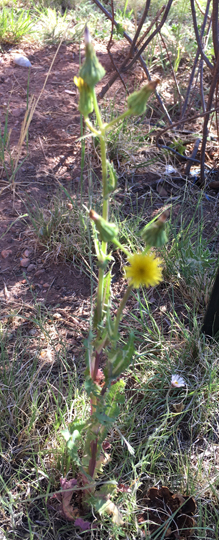
Location
Outside Visitor Center (N35D33'02.100 X W105D41'10.691)
Flowers first observed: 6/14/17
Plant w/Flowers

The Flower

Distribution
"One of the more predominant plants in Arizona Common or Annual Sowthistle is a major weed species throughout the country. Because it is so prolific, this weed competes with other more "desirable" plant species. It has become naturalized from Europe and is sometimes difficult to distinguish from the similar Spiny Sowthistle, Sonchus asper. One of the main differences, as the name implies, the latter is spinier." (Southwest Desert Flora)
Description
"Growth Form: Forb/herb; basal leaves, branching above; stems hollow, mostly hairless (glabrous) ooze milky sap when broken. Leaves: Green, light or dark green; alternate; basal leaves; upper leaves variable in plant, oblong, obovate, lanceolate, often winged at base, spiny edges deeply lobed. Flower Color: Yellow; flowers small about ½ to 1 inch, on tips of flowering stalks; strap-shaped (ligulate) flowers only in clusters on open branches; flowers usually bloom mornings to mid-mornings; fruit is an achene with white hairs on one end, seeds are wind dispersed. Flowering Season: March to September. Elevation: 500 to 4,500 feet.
Habitat Preferences: Throughout the state, roadsides, yards, gardens, fields, along streams and disturbed areas." (Southwest Desert Flora)
Ethnobotanical Uses
Food:
"Young leaves have been added to salads or cooked as a hot vegetable (served with butter and seasonings or vinegar) or as a potherb. They are sometimes added directly to curries and rice dishes, but they are usually quite bitter and require at least 1 change of water. Older leaves soon become very bitter and tough." (Kershaw 166)
"---Pima Unspecified Tender leaves rubbed between the palms and eaten raw. Stalks peeled and eaten raw like celery." (Moerman 538)
Medicine:
"In the 13th century, sow thistles was recommended to prolong the virility of gentlemen, perhaps because of its milky sap. It was also believed to increase the flow of milk in nursing mothers. Some herbalists recommend sow thistle for use in salves for healing hemorrhoids, ulcers and other skin irritations and as a bitter and a tonic. The dried sap of annual sow thistle was used to treat opium addiction. Medicinal teas made from perennial sow thistle have been used to calm nerves and to treat asthma, bronchitis and coughs. The leaves were used in poultices and washes for relieving swelling and inflammation, and the milky juice was used to treat inflamed eyes." (Kershaw 166)
"---Navajo, Kayenta Heart Medicine Plant smoked or taken for palpitations. (Moerman 538)
Other Uses:
"The white, milky sap was believed to clear the complexion. It was also dried in balls and chewed like gum. The flowers can be used as a pleasant-tasting, gummy chew." (Kershaw 166)
Internet Links